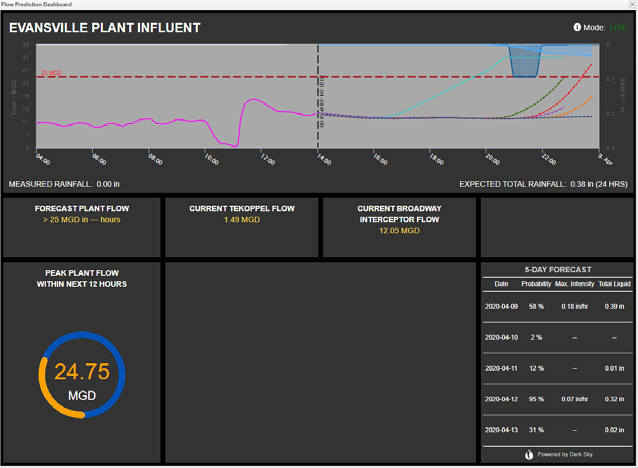Hydroinformatics 101: Intro To Water Optimization And Efficiency
By Bryant McDonnell

Hydroinformatics offers a fresh perspective that is enabling communities around the world to tackle ageold problems in new ways and with a bigger toolset.
The water sector is in the throes of a bold transformation, driven by technology and smart water infrastructure. While advanced digital solutions have been leading the charge, there is a powerful, lesser-known force driving this disruption — hydroinformatics. Evolving from the early discipline of computational hydraulics, hydroinformatics is the application of information and decision support systems to address the equitable and efficient management of water.
Hydroinformatics engineers thrive from multidisciplinary perspectives, folding in expertise from traditional civil and environmental engineering, signal processing, machine learning, and control theory. Similar to computational hydraulics, hydroinformatics relies on the digital simulation of water flows and related processes but focuses on its application rather than the technology alone.
The Holistic Approach Of Hydroinformatics
Combining smart technologies with real-time data analytics and both physics- and non-physics-based models, hydroinformatics engineers work with clients to develop the next generation of sustainable, efficient, and autonomous water systems. As the industry continues to embrace digital solutions, water networks are becoming more and more instrumented. Therefore, the accurate and granular sensing of data is of fundamental importance to the application of digital systems in order to deliver high-quality results that inform better decision-making.
In a collaborative practice, hydroinformatics teams often work in conjunction with software developers to design solutions that optimize water and wastewater networks. Hydroinformatics engineers begin by analyzing a particular client’s challenges to come up with a highly configured algorithmic solution, such as a control strategy using existing assets, which can then be optimized with a genetic algorithm to work under an array of hydraulic conditions.
Optimization objectives can include (but are not limited to) adverse hydraulic conditions (such as flooding, overflows, high pressures), energy usage, and capital costs. Possible solutions are implemented, tested, and further refined with each iteration by hydroinformatics engineers to become solidified, before collaborating with software developers to bring a real-time decision support system into production.
The data collected, combined with the expertise to evaluate how these data correlate with a utility’s day-to-day operations, result in solutions that promote greater system visibility for early intervention. Such solutions are both sustainable and cost-effective, supporting long-term resiliency and capital planning.
Hydroinformatics In Action
Take smart network optimization systems, for example. Sewer overflows are a growing problem for many utilities in the U.S. and around the world, and with instances of severe weather on the rise due to climate change, utilities are challenged with managing them effectively in an affordable way. Xylem’s end-to-end wastewater optimization solution integrates directly into existing wastewater networks, using a combination of sensors and weather data, digital twin technology, and optimization algorithms to drastically reduce sewer overflows, minimize flooding events, and optimize functionality while maintaining regulatory compliance.
Serving a population of more than 850,000 people over 290 square miles, the Metropolitan Sewer District of Greater Cincinnati (MSD) operates combined and sanitary sewer systems, some of which were built more than a century ago. The systems were built to collect rainwater runoff, domestic sewage, and industrial wastewater in the same pipe. Whether by design or due to infiltration and inflow of stormwater they have a tendency to overflow, discharging an average of 14.4 billion gallons of combined sewage every year into the Ohio River and its tributary streams within Cincinnati’s urban watershed.
In 2002, the U.S. EPA entered into a federal consent decree with MSD, mandating the elimination of sanitary sewer overflows and significant mitigation of combined sewer overflows into receiving waterways. Engineers estimated the cost to mitigate the sewer overflows through capital investments at $3.1 billion, an unacceptable capital expense to pass along to MSD’s customers.
To overcome these challenges MSD partnered with Xylem to optimize the performance of their existing assets through advanced digital optimization solutions. Xylem worked with MSD to implement Xylem’s Wastewater Network Optimization solution that utilizes a combination of sensors and weather data to create a real-time decision support system (RT-DSS) that delivers automated, optimized control of existing assets to reduce sewage overflows while maximizing storage and treatment plant operations during wet weather.
After MSD implemented a coordinated real-time control (RTC) program, overflow volumes were reduced by 247 million gallons annually, representing a 45 percent reduction in overflow compared to the original design. Additionally, operational enhancements from the project increased treatment facility utilization by more than 100 percent, the result of more efficient use of existing assets.
Taking a similar approach, the City of Evansville in Indiana reduced its sewer overflows by more than 100 million gallons a year. Leveraging the same wastewater network optimization technology, the city effectively provided a software upgrade to its existing sewer system — allowing water managers to collect and analyze valuable data insights and convert the city’s existing network into infrastructure that is more resilient and affordable.
With real-time situational awareness of critical data points throughout the system, the city now has the visibility needed to allocate resources accordingly during instances of severe weather events.

Flow prediction dashboard from the City of Evansville
A New Future For Water Management
With challenges surrounding water availability, water quality, and water-related natural disasters set to increase in the near future, the time has come for utility managers to think smarter about water. This unique and relatively untapped discipline can transform utility operations by prescribing cost-effective and adaptive solutions that level the playing field and solve the world’s most complex water challenges.
With robust and high-resolution data and decision support forecasts coming online, the future of water network management will become capable of running a self-discovery of problems accompanied by recommendations to operators on the best mitigation strategies and respective outcomes. This will ultimately enhance resiliency in the face of unforeseen threats, decrease capital costs on infrastructure upgrades, and protect the environment to promote a sustainable and efficient approach to urban water management.
About The Author
 Bryant E. McDonnell serves his team as the Senior Manager of Hydroinformatics and Process Control for Xylem. He is a Professional Engineer (OH, KY, NE, MO) and has degrees in civil and environmental engineering from Southern Illinois University Carbondale and the University of Cincinnati. He is an autodidactic analytical software programmer and has been working in the hydroinformatics space for over 10 years. He was the original author behind OpenWaterAnalytics-PySWMM (Python Programming Interface to Stormwater Management Model) open-source software library. He is passionate about solving old problems in new ways to save money for public utilities and their ratepayers.
Bryant E. McDonnell serves his team as the Senior Manager of Hydroinformatics and Process Control for Xylem. He is a Professional Engineer (OH, KY, NE, MO) and has degrees in civil and environmental engineering from Southern Illinois University Carbondale and the University of Cincinnati. He is an autodidactic analytical software programmer and has been working in the hydroinformatics space for over 10 years. He was the original author behind OpenWaterAnalytics-PySWMM (Python Programming Interface to Stormwater Management Model) open-source software library. He is passionate about solving old problems in new ways to save money for public utilities and their ratepayers.
